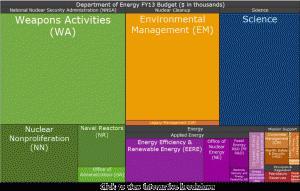 As part of the massive $3.8 trillion dollar federal budget proposed recently by President Barack Obama, $27.2 billion was geared toward the Department of Energy (DOE). For those interested, here is a PDF of the DOE budget. Secretary of Energy Stephen Chu provided details of the budget proposal as it pertains to his office. In the press release from the Department of Energy, Chu was quoted as saying:
As part of the massive $3.8 trillion dollar federal budget proposed recently by President Barack Obama, $27.2 billion was geared toward the Department of Energy (DOE). For those interested, here is a PDF of the DOE budget. Secretary of Energy Stephen Chu provided details of the budget proposal as it pertains to his office. In the press release from the Department of Energy, Chu was quoted as saying:
‘The United States is competing in a global race for the clean energy jobs of the future . . . The choice we face as a nation is simple: do we want the clean energy technologies of tomorrow to be invented in America by American innovators, made by American workers and sold around the world, or do we want to concede those jobs to our competitors? We can and must compete for those jobs. This budget request includes responsible investments in an American economy that is built to last.’
For a bit of perspective, the National Nuclear Security Administration (NNSA) will receive 42.48% of the DOE’s total budget. Nuclear Clean Up, a separate section of the budget is in line to receive another 21.54%. A bulk of the clean up funds goes to Environmental Management (comprising just under 21% of the total budget for the DOE). As part of the NNSA, nearly 28% of Department’s total budget is directed toward Weapons Activities. In contrast, Energy Efficiency and Renewable Energy (EERE) will receive 8.6% of the funds for the Department. Here is a PDF of the EERE Budget Request.
The aforementioned press release provides the following specifics from the President’s FY 2013 budget request for the Department of Energy:
- Invests in cross-cutting research to lead in the research, development, deployment and production of clean energy technologies;
- Promotes efforts to make solar power affordable for all Americans by reducing the cost of solar energy by 75 percent and making it cost competitive without subsidies by the end of the decade;
- Continues the Obama Administration’s efforts to reduce our dependence on oil by one-third by 2025;
- Supports groundbreaking basic science, research and innovation to solve our energy challenges and ensure that the United States remains at the forefront of science and technology;
- Strengthens national security by reducing nuclear dangers and maintaining a safe, secure and effective nuclear deterrent; and
- Advances responsible environmental management by cleaning up the legacy from the Manhattan Project and the Cold War.
Some highlights in the FY 2013 budget include:
- $60 million to perform critical research on energy storage systems and devise new approaches for battery storage;
- $770 million for nuclear energy, including $65 million for cost-shared awards to support first-of-a-kind small modular reactors and $60 million for nuclear waste R&D that aligns with the recommendations of the Blue Ribbon Commission on America’s Nuclear Future;
- $276 million for research and development of advanced fossil fuel power systems and carbon capture, utilization and storage technologies to allow for the continued use of our abundant domestic coal resources while reducing greenhouse gas emissions;
- $350 million for the Advanced Research Projects Agency-Energy (ARPA-E) to continue support for promising early-stage research projects that could deliver game-changing clean energy technologies;
- $120 million to support the Energy Frontier Research Centers and $140 million for the five existing Energy Innovation Hubs and to establish a new hub to focus on grid systems and the tie between transmission and distribution systems;
- $11.5 billion to protect Americans by maintaining U.S. nuclear deterrence capabilities, reducing nuclear dangers in an increasingly unstable and unpredictable world, and providing for the Navy’s nuclear propulsion needs; and
- $2.5 billion to support NNSA’s Defense Nuclear Nonproliferation program, which plays a critical role in completing the President’s goal of securing all vulnerable nuclear material around the world in four years.
[Image source]

